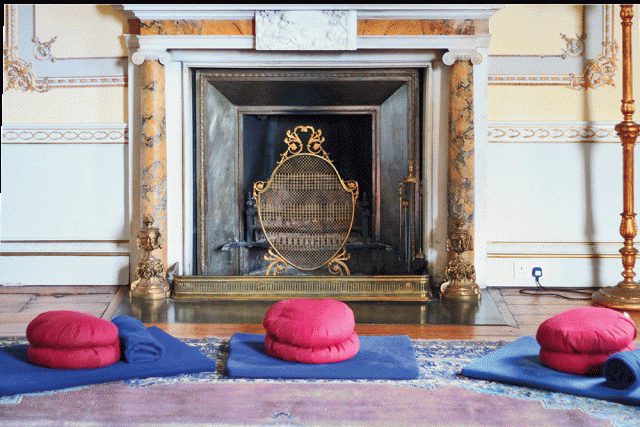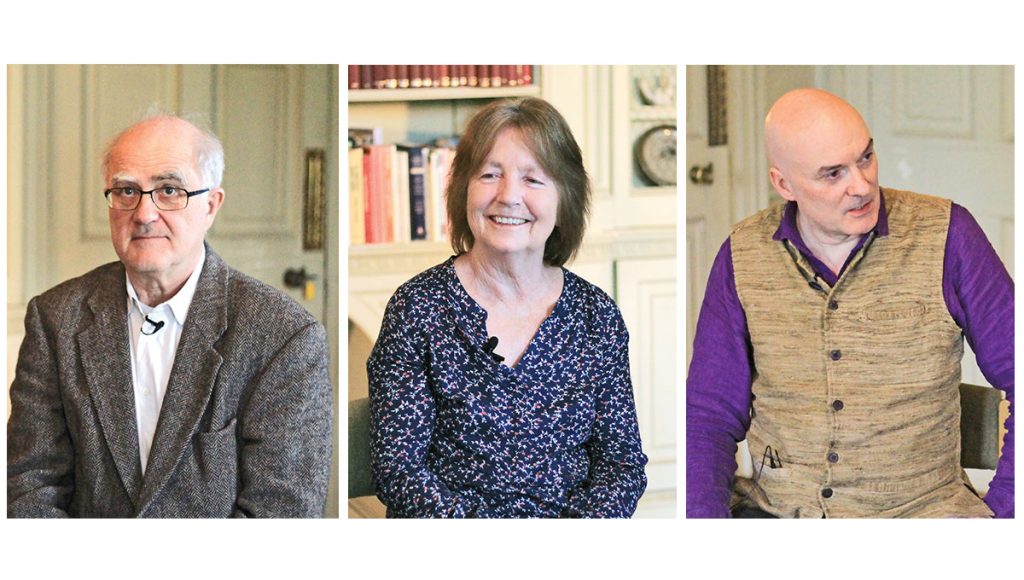Anyone who has read even the most introductory Buddhist books will have come across the phrase “the four noble truths,” referring to the tenets that form the bedrock of the Buddhist worldview. These four truths are generally understood as the historical Buddha’s realization that (1) life inevitably contains suffering; (2) this suffering is caused by craving and clinging to impermanent things; (3) suffering can be ended by cutting the roots of craving; and (4) this can be achieved by following a path outlined by the Buddha. But is the translation of “noble truths”—a phrase that is thoroughly embedded in Western Buddhist discourse—correct? And what would it mean for our practice if it weren’t?
In the following conversation, three of the five core teachers of Bodhi College, an online educational center focusing on a secular understanding of the dharma, explain why they say these truths are due for a fresh translation and reassessment.

Stephen Batchelor (SB): I have a problem with using the word “truth” at all for what’s usually translated as “the four noble truths.” We’d be much better off if we abandoned that language. As soon as we bring up this notion of truth, we’ve framed everything within the idea that there is some reality we have to understand: truths are things that you understand or you don’t understand. But I don’t think that’s what the Buddha is trying to do here. He’s actually asking us to embrace suffering; he’s asking us to let go of craving; he’s asking us to see the stopping of craving; and he’s asking us to cultivate a way of life, which is the way it’s explained in his first sermon, the Dhammacakkappavattana Sutta (“The Setting in Motion of the Wheel of the Dharma”). And you can say all of that without any reference to the word “truth” at all.
“Noble truth” is very possibly a kind of Buddhist rhetoric. All religions claim to teach noble truths; in a sense, it’s a given in this kind of discourse. What would happen if we stopped using that language? I think it would free us up to give primacy to the practices.
Christina Feldman (CF): Well, actually, I would agree.
SB: I thought you’d agree.
CF: [Laughs.] I am uneasy with the whole phrase “four noble truths.” First, these are interactive understandings, not separate, fragmented pieces where we can choose one or the other. Second, as soon as we use the word “truth,” we get into an absolute way of thinking instead of living these truths as a dynamic process that is happening moment to moment. They are something that we’re actually invited to see and to understand for ourselves.
These “truths” are not observances; they’re not something historical, like “twenty-six hundred years ago the Buddha invented the four noble truths.” What the Buddha was describing was the process of getting into optional difficulties and pain and distress that could come to an end. So these are liberating investigations, which are only valuable if you can take them into your own experience and see if they are true for you. This kind of framework is a primary way of learning to be honest with ourselves and with what’s going on in our lives. Instead of being mystified and bewildered and saying, “How did I end up here in this awful anguish?” we can actually come to understand exactly how we ended up there, and that understanding is, of course, the key to not reentering those cycles of distress.
Akincano M. Weber (AW): We also have good reasons to believe from the very old traditions that the four noble truths have always been understood in different ways. It’s very interesting to look at how the early commentators actually related to the term. In the commentary to the Digha Nikaya (“The Collection of Long Discourses”) and Anguttara Nikaya (“The Collection of Numerical Discourses”), two of the collections of texts from the Pali canon, for instance, the term is glossed as “these truths are the truths of the noble ones.” So our oldest canonical references to these teachings make it clear that “noble truth” is probably a misnomer, and yet it became the term with which most people are familiar.
The doubt about the exact doctrinal content of the term ariyasatya in Sanskrit or ariyasaccani in Pali has been there for a hundred years, from the Russian 19th-century Indologist Fyodor Stcherbatsky up to the present-day British philologist K. R. Norman, who has looked at this topic very carefully. The conclusion is fairly clear: anyone who knows the languages will know that the term can be broken down in a number of ways, and “noble truth” is likely the least useful way to do it. Probably the best and closest translation is something like “engaging with these truths, practices, or themes is an ennobling pursuit.”
“As soon as we use the word ‘truth,’ we get into an absolute way of thinking instead of living these truths as a dynamic process that is happening moment to moment.”
SB: K. R. Norman also argues that in the earliest version of the presentation, the term ariyasaccani wasn’t there; it was stitched in at a later point. I see the addition of the term as a reflection of how the dharma, over a period of time—although we don’t know exactly what that period is—mutated, how what started out as a way of life or a practical philosophy became more and more aligned with a form of an Indian religion. I think what might have happened is that as the dharma began to evolve into Buddhism, quite understandably it then had to deal with the “competition”: the Brahmins and the Jains and the Ajivikas and the other schools of ancient India, each of whom claimed that what they taught was the truth and that their truth was truer than the other guy’s truth. And so the Buddhists, I think, got drawn into the game of making truth claims in order to have the status of being a respectable religion alongside the others, so it would have more credibility in the eyes of the people, the kings, and the various ascetics who were around at that time.
CF: It’s important to remember that we’re not endeavoring to reframe this very central teaching in order to be clever or to somehow imagine that the Buddha didn’t actually teach these things. What we’re endeavoring to do is to bring this liberating teaching into something that is an ongoing question, that question being, what is it that is ennobling?
Now, it’s curious: in English, we would hardly ever use the word “ennobling”; it doesn’t have any meaning for most people. I think that the Buddha was really asking: What is it that brings dignity to your life? What is it that allows you to live without regret? What is a way of living that is imbued with respect and blamelessness? What is a way of living where you’re no longer hostage to the world of conditions? What is a way of living where your mind is actually a friend rather than something that torments you?
It’s important to remember that the Buddha, as much as he was a contemplative, was also a social activist. He was not just concerned with personal development and freedom. He was also concerned with the kind of world that people lived in and created together, either through ignorance and confusion or through respect and integrity. So my own sense is that the teaching of these ennobling understandings is not just about personal well-being. They continually ask this question of us, which is of grave immediacy: What is it that ennobles our lives, which we can then communicate to the world around us through the ways we engage with that world?
SB: That points to how the Buddha’s vision was centrally ethical. I’m not referencing the moral precepts here and so on; by ethical I mean leading a way of life in which you try to become the kind of person you aspire to be and try to create a world that you aspire to live in.
My problem is that the word “truth” gets in the way of that. In the Sutta Nipata, one of the oldest collections we find in Pali, there’s a line where the Buddha actually says that he does not claim truth. He says that “This is true” is what fools say to one another. So he’s very skeptical of truth claims in these earliest texts, because they lead inevitably to quarrels, which is another one of the things the early scriptures are constantly warning us against: getting drawn into disputes.

CF: The Buddha is constantly identifying this world of division and conflict and how it comes into being, which is why many of the discourses are framed as a conversation between two people who are quarreling or between the Buddha and someone who is trying to quarrel with him. Much of the time those quarrels are created through identification with view. “I am right. And if I am right, you are wrong.”There’s a very fine line between what we call a truth and a view: the latter is used to create a sense of position and a self that in turn becomes the foundation for more suffering.
SB: Again, as long as you’re using the word “truth,” you’re going to be just a whisker away from having a dogmatic view. If we take, for example, the second noble truth as it is usually translated—that “craving is the origin of suffering”—to me that is a metaphysical statement. You’re making a very generalized claim about the nature of reality, and so immediately people get drawn into the discussion: Well, is that really true? What about this? What about that? And down you go into the rabbit hole of theology. Whereas if you frame it as a task, the challenge is: how do I let go of craving? Then you are setting up a whole different doorway to the thoughts and the discussions that follow. Your discussion inevitably will be pragmatic. It won’t be, “Is this true? Is this false? Is this right? Is this wrong?” but, “How do you get it done?”
It’s like the very famous example of the person who is wounded by a poisoned arrow and his friends want to take it out, but he won’t let them until he knows the name of the man who shot it and so on. And the Buddha says that he doesn’t teach all of these metaphysical views, that all he’s interested in is “how do you get the arrow out?” How do you let go of craving? That’s all that matters. The rest is speculation.
AW: But there’s a slight tension in there. If you look at the framing of the second truth in the Dhammacakkappavattana Sutta, it states literally that craving is the origin of suffering. But if you look at other teachings, the problem doesn’t seem to be craving primarily, but ignorance. Buddhist traditions have played that against each other for many centuries, whether the major problem is a lack of understanding, so that all it takes is to open your eyes and wake up from the sleep of not knowing; or whether the solution is to gradually wean yourself from bad habits and come to create wholesome activity on the basis of an attitude to the world that is guided by the four forms of empathy.
Anyway, if I am pressed to state something about the teaching on the four “truths,” I’ve been greatly inspired by the English monk Nanavira Thera, who says in a letter to one of his supporters in the mid-’60s that he understands the four truths by way of an Alice in Wonderland analogy. Alice doesn’t have a bottle that describes its contents. She finds a bottle that tells her what she should do with the contents—“Drink me”—and then things happen: she shrinks and grows and so on. In the Buddhist application of the analogy, the label on the first truth says, “Understand me.” On the second of the truths, the label says, “Give me up.” On the third bottle, it says, “Realize me,” and on the fourth bottle it says, “Develop me.” So if we boil down the teaching of these four truths, they are four different calls to action.
And the first one is not to believe me; it’s to understand me.
SB: That’s the point, I think. See, with the whole issue of craving, it’s so easy to get into questions of where it comes from or what it produces, all of which can be very insightful, but none of which can really address the primary experience of what it’s like as a sentient creature to crave, to grasp, to fear, to hate. What is that actually doing to me psychosomatically, and how do I work with that? It’s all very well to say, “Give me up; let go.” How the hell do you do that?
In other words, if we start thinking more in terms of tasks than truths, that makes it all eminently practical. In a sense, at that point, the broader truth claims become irrelevant. Does it really matter whether craving causes suffering or not? Well, that’s interesting, but the real practice, the real challenge, is to enter into a relationship with my craving in which I transform that experience from one that traps me and binds me and keeps me stuck into one that makes me free.
♦
Continue studying with Stephen Batchelor, Christina Feldman, John Peacock, and Akincano Weber in The Four Noble Truths, a six-part online course available through Tricycle Online Courses.
Thank you for subscribing to Tricycle! As a nonprofit, we depend on readers like you to keep Buddhist teachings and practices widely available.
